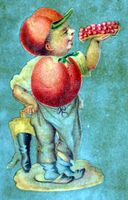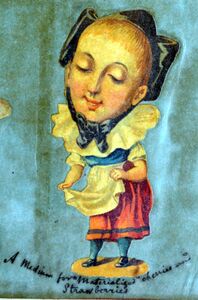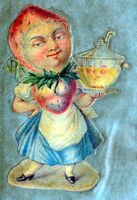< Stigmatisation (continued from page 7-28) >
This abolition of sensibility and thought during ecstasy has been traced to the vaso-motor centre, which we have mentioned. We all know that if the medulla is cut behind the tubercula quadrigemina, four or five millimetres in front of the point of the calamus, the posterior limit of the vaso-raotor centre, the excitation of the sensory nerves is not capable to produce any vaso-motor reflex action. This being so, it may be inferred that, if the abolition of sensibility and reflectivity exists, and this existence is proved, both in ecstacy and in the separation of the bulbous centre from the rest of the organism, an equal agreement will result from the excitement of the same centre. The vaso-motor apparatus is, in fact, composed of the ganglionic chain of the great sympathetic nerve, and of ganglia disseminated along the course of the vessels on one side, and of the grey matter of the medulla on the other. It is the bulbar centre which commands the vaso-motor action; from it all radiates, and to it all converges. Its direct or reflex excitement may occasion paralysis, which produces the same effects as division of the fundamental chord. Physiological experiment thus accords with the conditions produced by pathological syndroma.
Dr. Warlomont at length discusses the extent to which scratching plays a part in the production of the stigmata. Whether voluntary or instinctive, the artificial excitement of the sores has aided powerfully in their formation. The reason of this is found in the action of the vaso-dilator nerves, which rubbing has enlarged by a reflex method. Continual scratching of the stigmatic localities has produced an access of strength to the vaso-motor paralysis. This association of diseases has always produced surprise. There is, nevertheless, a psychological law of contiguity, or association, which accounts exactly for the succession of the two terms, ecstasy and stigmatisation. When paralysis of the vaso-motor centre commences, i ecstasy is always likely, for the reason that, when the mind is attracted to the succession of the two stages, the first has already become a permanent idea, and attention is fixed on the second.
As for the regularity and periodicity of the attacks, it is explained by the law of similarity, by which like produces like. The absorbing power of the fixity of the idea, and the persistence of pain in the hands, exclude in Louise Lateau all tendency to diversion of thought, and it would be surprising if the greatest attacks should take place at a different date to that of the Friday, which is associated in her mind with such events. Ecstasy and stigmatisation are, therefore, neuroses, to which the name of “stigmatic neuropathy” has been given. As Brown Sequard says, “To say that an explanation is good, because it is the only one we know,” is an argument which is rarely of value in scientific matters; but when the explanation is probable and intelligible, the absence of any other intelligible explanation should be noted. Professor Virchow’s suggestion that Louise was entirely an impostor is not proven, and the experiment on the hands is sufficient to ensure its rejection. The fraud by which it is clear that she does not fast, when she pretends to fast, is sufficient to show that we have to deal with a girl who, consciously or unconsciously, is so far like some physical mediums, that she does not habitually speak the truth. Dr. Warlomont seems to hold the balance very carefully between the two hostile camps, and I am thankful that, for the first time since the controversy commenced, a trustworthy account of this girl has been given us. I feel certain we have not yet heard the last of her, and that some further attention will be directed to the subject.
I carefully abstain from comparing this case of Louise Lateau with the numerous other cases of stigmatisation which have been recorded in past history. The chief one of these, which will most readily occur to our minds, is that of St. Francis of Assisi. The symptoms, however, shown in this case were wholly different to those of Louise. We fortunately possess a precise account of these symptoms from the pen of one who was, perhaps more than any other, intimate with St. Francis, and his biography, given by St. Bonadventure, tells us what these symptoms were.
The words of St. Bonadventure are—
“Statim namque in manibus et pedibus ejus apparere cceperUnb signa clavorum; ipsorum capitibus in inferiori parte manuum, et superiori pedum apparentibus, et eorum acuminibus existentibus ex adverse. Dextrum quoque latus quasi lancea transfixum rubra cicatrice obductum erat; quod ssepe sanguinem sacrum effundens tunicam et femoralia respergebat.”—Legenda Sancti Francisci, cap. 13.
Such conditions, in which apparently an induration of integument existed within a limited area, bear no resemblance to the stigmata of Louise, and it is nowhere stated that blood, in the case of St. Francis, flowed from the wounds in the hands and feet.
The bearings of the whole subject of stigmatisation on spiritual science will, of course, be keenly criticised. On the theory that the case of Louise Lateau is not an impostor (and whether or not she be one, she undoubtedly bleeds at periodical times, apparently independently from her own volition), she shows a very peculiar and abnormal physical condition.
The theory that “will power” may produce a special secretion of blood, at particular times, will naturally commend itself to those masters in psychological science, the occultists, to whom on this, as on other subjects, we look for information and instruction. It would not be fitting for a mere physiologist like myself to offer an opinion, or to hazard a theory. If, however, a number of cases like that of Louise Lateau should be carefully investigated, and, if it was possible to divest the subject from the prepossessions and bitterness which have surrounded it, I venture to think that psychological science would be advanced.
In conclusion, I have only to say that I have (whatever my private, feelings may be) endeavoured to avoid any expression of opinion on the theological bearings of the subject, and that I hope that, with us, at least, the matter may be discussed merely on the grounds of the scientific aspect of the question.
 |
 A Medium for "Materialized" cherries and Strawberries
|
 |
Editor's notes

